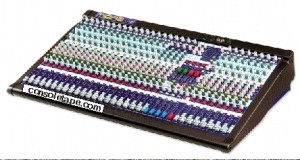
For as long as anybody can remember, the inner cardboard hub of a roll of console labeling tape has been 3 inches.
It is unlikely that the diameter of the hub had anything to do with being just the right size to fit around most peoples’ wrist, but it is the perfect size for that.
When you are doing lots of labeling, there is no more convenient way to get a small piece of tape than to be able to use your non-writing hand as a sort of tape dispenser.
Just slip your hand through the hub and you can hold one, or even several rolls of tape right where you need them without losing the ability to use both hands.
Not coincidentally (my guess) the hub size of gaffers tape, which is also three inches, was probably also a “lucky accident”.
TheTapeworks.com
Voice 866-386-8335
Fax 800-327-6651
Email sales@harrisonbros.com
Harrison Bros. Inc.
47 North Chatham Pkwy.
Chapel Hill, NC 27517






 We’ve wriiten about console tape specs before, explaining why terms like “adhesion to steel” and “flatback” matter when evaluating a console tape.
We’ve wriiten about console tape specs before, explaining why terms like “adhesion to steel” and “flatback” matter when evaluating a console tape.
